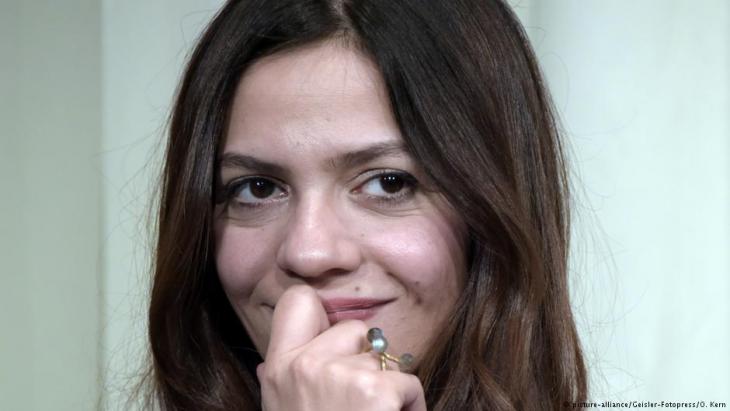Naked despair laid bare

It begins in a psychotherapistʹs overcrowded waiting room. Kamilʹs practice in Damascus is overrun with patients every day; men and women looking for help, old and young alike, suffering from psychological disorders – and not just victims, either. There are also perpetrators among them, muscular young men with unfriendly, piercing gazes, seeking help from Kamil.
Sulaima has been coming to this practice for six years. She is dogged by anxiety and panic attacks and relies on medication to be able to lead something approaching a normal life. Her conversations with Kamil are often her only foothold in a life shaped by suicidal thoughts and loneliness. Every time she feels an attack coming on, she swallows half a Xanax. Over the course of the novel, she increases the dose – but it doesnʹt stabilise her psyche. Instead, it leads to delusions.
Her illness puts the young artist in a state of increased alertness; she pays attention to what is happening around her relentlessly, registering the smallest of changes in other peopleʹs faces and movements. Itʹs no wonder she canʹt paint any longer. She is a born observer, who describes both her environment and her own feelings and mood swings in minute detail. But she isnʹt doing this entirely voluntarily; itʹs a kind of compulsion, an excess of suffering that she calls "the fear of fear".
In the cycle of fear
There isnʹt a single line of the novel in which Sulaima is able to escape her feelings of fear. The same goes for the other protagonists: fear seems to be a collective pattern that structures the days and nights of all the novelʹs characters and rules their inner lives.
Nassim, a young doctor and writer whom Sulaima meets in the waiting room, is so tormented by his fears that he has got into the habit of slapping himself. Like Sulaima, he is a victim of his countless fears, but he takes a more aggressive approach to tackling them. He has had his name and address tattooed in large letters on his back, in case heʹs killed by a bomb and this is the only way to identify him.
The relationship that Sulaima and Nassim start cannot last long, just as all other human relationships inevitably seem to crumble in modern-day Syria. But when Nassim leaves Syria, he gives Sulaima the manuscript of an unfinished novel that tells the story of a young woman whose life is surprisingly similar to her own.
This device allows Wannous to leave the constrictive radius of introspection and take the story to another level. In the "Nassimʹs Papers" chapters, we hear another womanʹs voice. She too lost her father early and has never got over the pain. Her brother came into conflict with the regime during a demonstration and was arrested; since then, he has "disappeared". The family is shattered and the young woman, who lives alone with her mother, decides to leave Syria.
All this has also happened to Sulaima, who is therefore convinced that Nassim has "stolen her life" for his novel. Shaken and fascinated at once, she reads what Nassim writes about this Salma, whom he seems to know so well. Finally, she decides to meet Salma in Beirut.
The feeling of "not belonging" and being close to madness
Wannousʹ narrative style is sober and often painfully precise when it comes to describing the details of human suffering. The novel never holds out the hope of a life free of fear. The protagonists feel they have lost their homeland; they suffer from a sense of "not belonging" and are often close to madness.
"I canʹt remember anything but fear," Sulaima says of her childhood. Even as a 14-year-old, she often spent all day weeping. She had just lost her father, who died of cancer. And of course, such a remorseless, radical perspective on the inner lives of the novelʹs characters does lead to speculation about how much of the plot is autobiographical.

At this yearʹs international literature festival in Berlin, Wannous emphasised the fictional aspect of the novel. As a writer, she said, she uses her imagination to get as close as possible to the novelʹs characters, even if certain set-ups are based on her own life.
Showdowns with her father
Thus the close relationship between daughter and father draws on Wannous' own story (her father was one of Syria's leading modern dramatists); however, this close relationship and the showdowns with her father are pretty universal in character – when defining the bookʹs characters, the memories of him are more likely to have helped than hindered her.
By contrast, Wannous dismisses another suspicion in no uncertain terms: the novel was not intended to make a prominent political statement and she doesnʹt see herself as a politically active author or a writer of "manifesto literature". Her representation of Syria is realistic and it also serves to transport the cruel reality of the countryʹs current state out into the world, in the form of literature ("even to Germany"), but the most important thing to her is the individuality of the people she portrays, making visible these damaged people and placing them in their environment, one in which all human relationships seem damaged.
The novelʹs political aspect admittedly becomes more concrete in later passages, especially where it highlights the fundamental brutality of present-day Syria. We learn that Nassim has had to spend thirty days in a torture prison (on a wing cynically known as the "department of death and madness") and we gain a greater understanding of the reason behind his fears and anxiety. Even the therapist Kamil, who functions as an anchor of calm in the text among other things, loses his strength towards the end of the book and is exhausted and helpless.
Seldom has a novel of such high literary quality spoken so clearly of naked despair and portrayed the irreparable split in society as powerfully as this penetrating, unsettling book does.
Volker Kaminski
© Qantara.de 2018
Translated from the German by Ruth Martin
